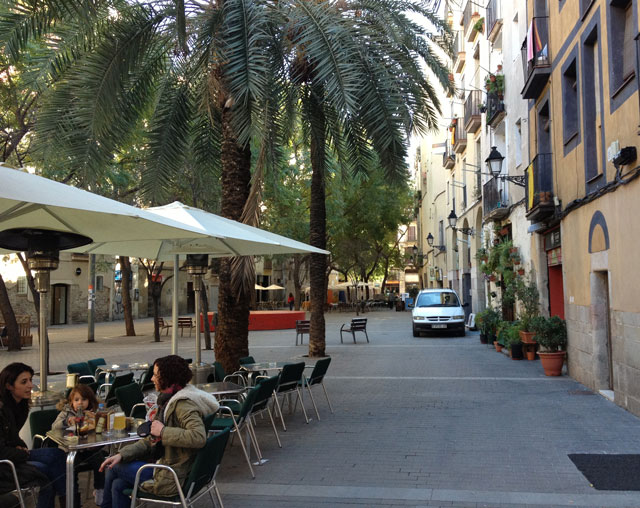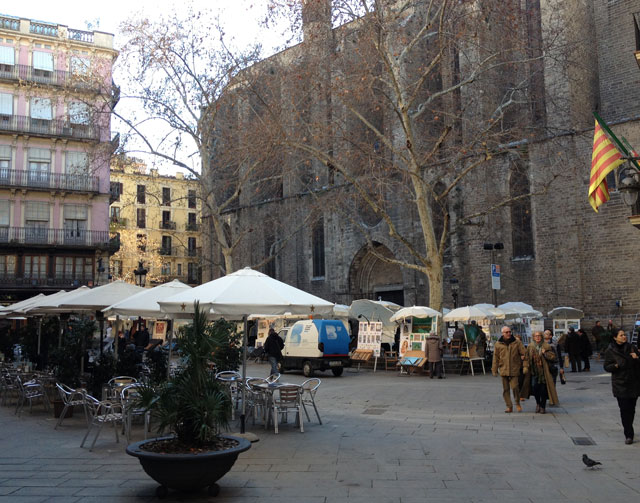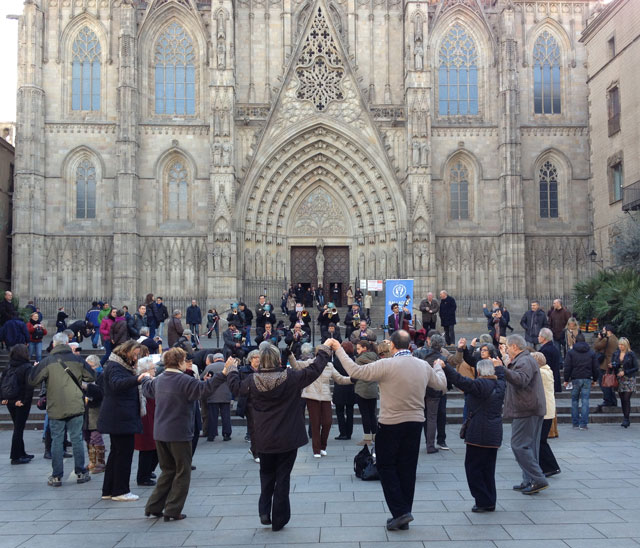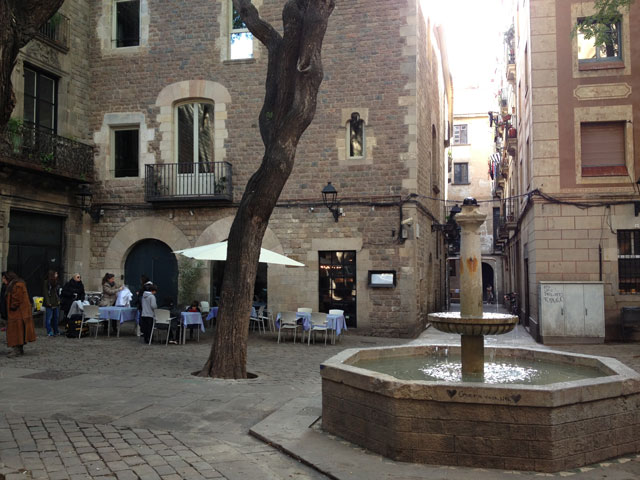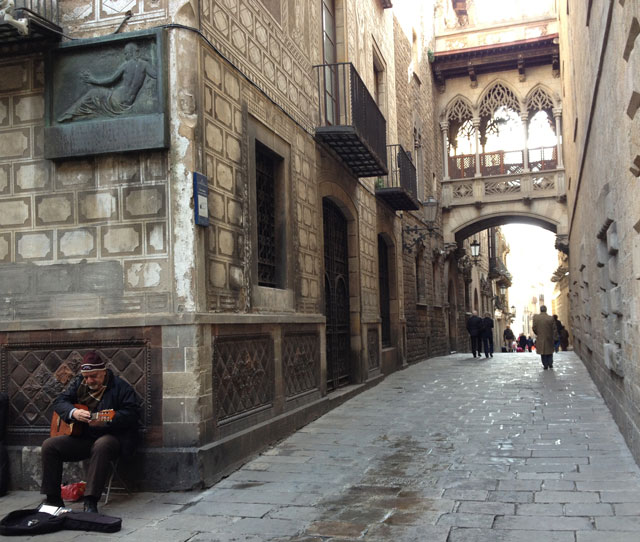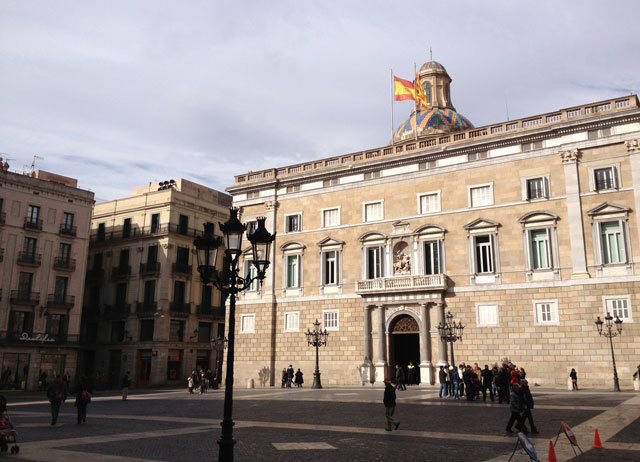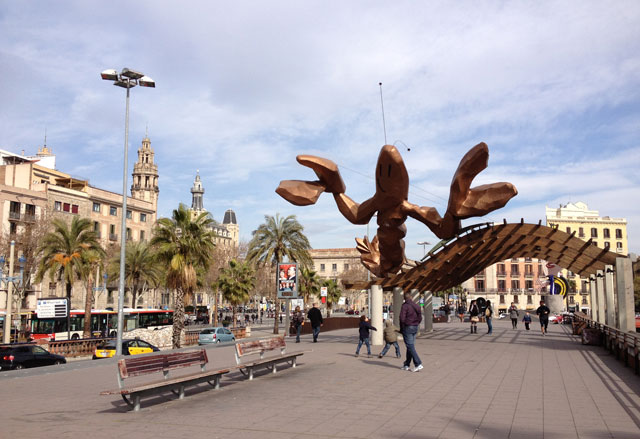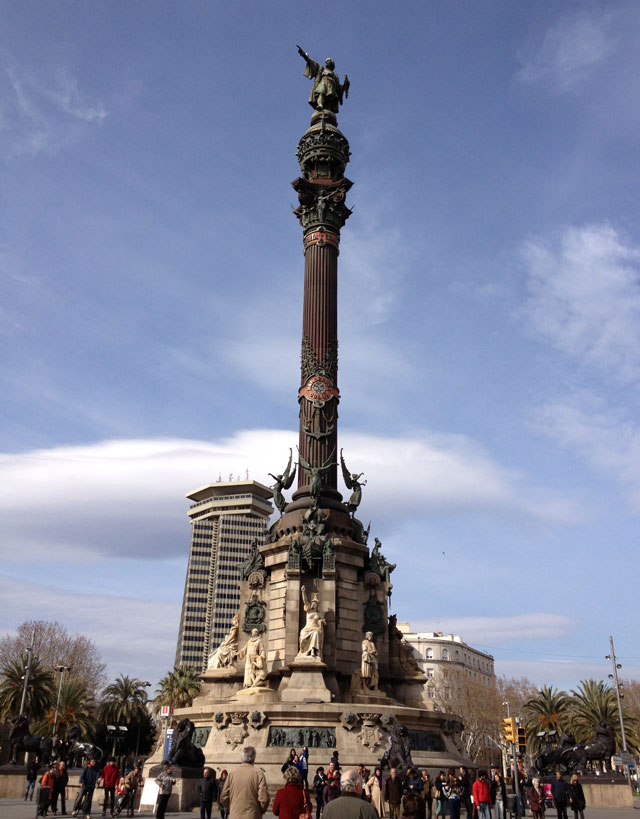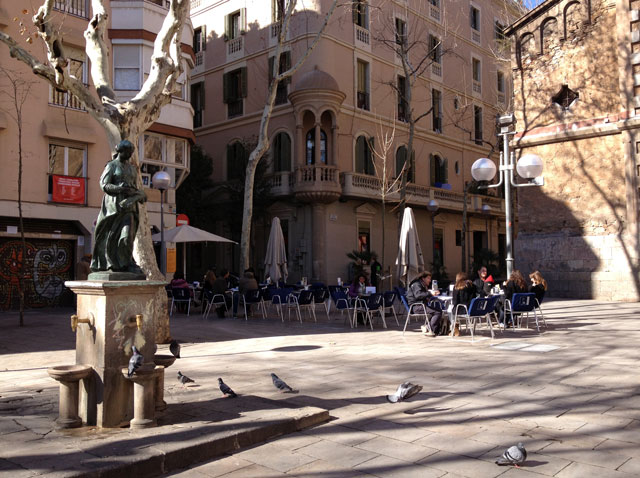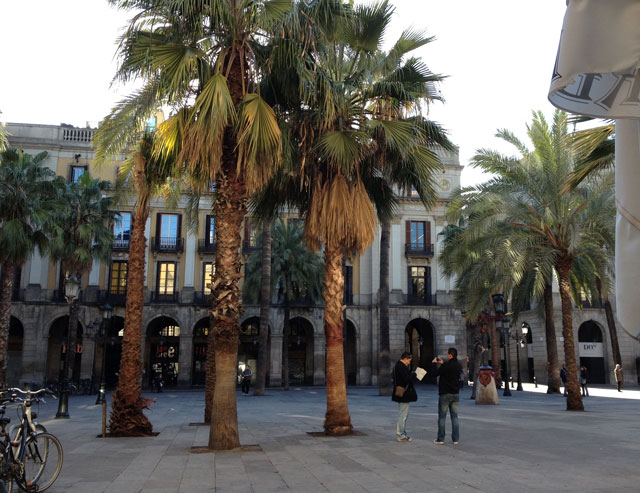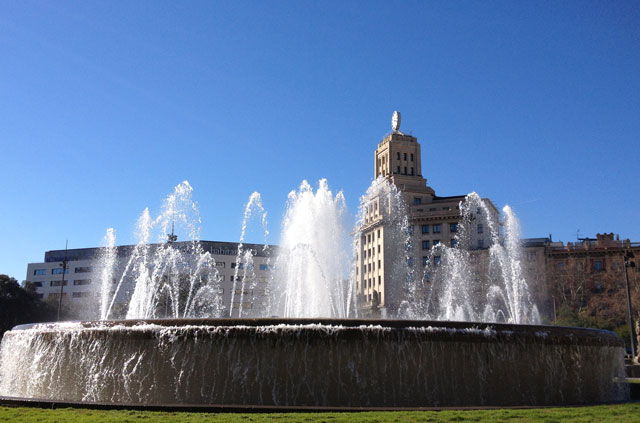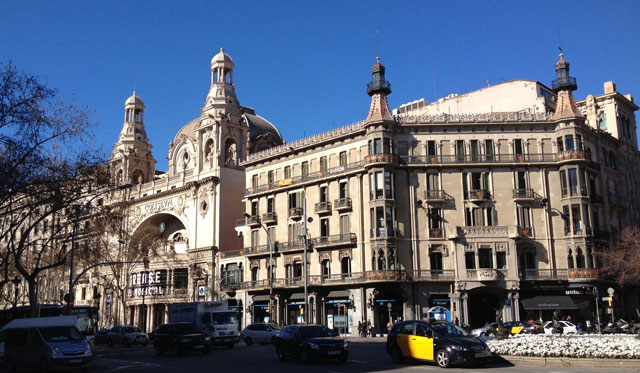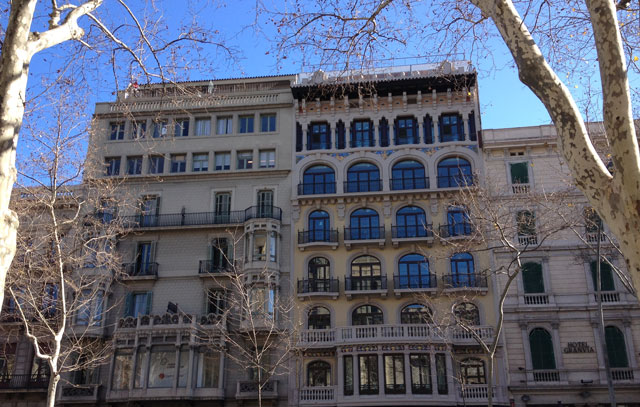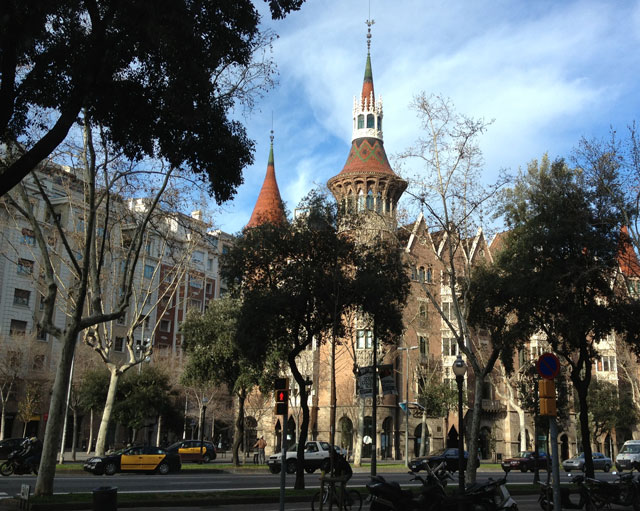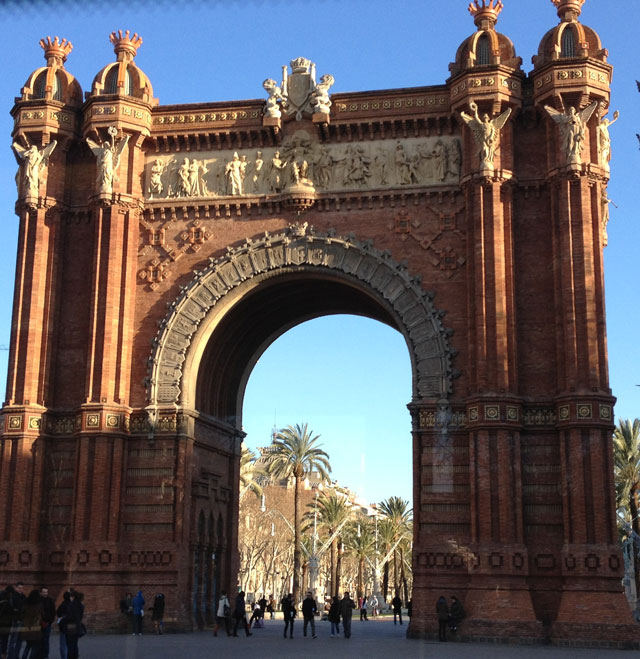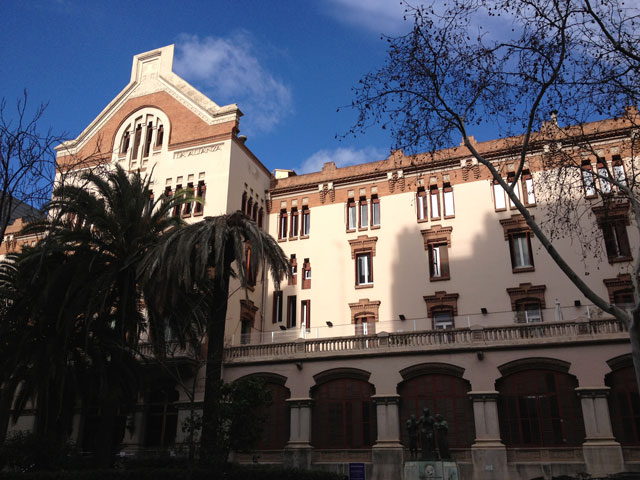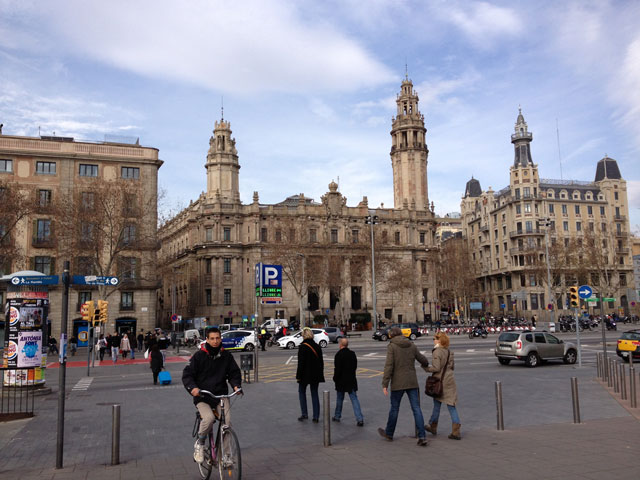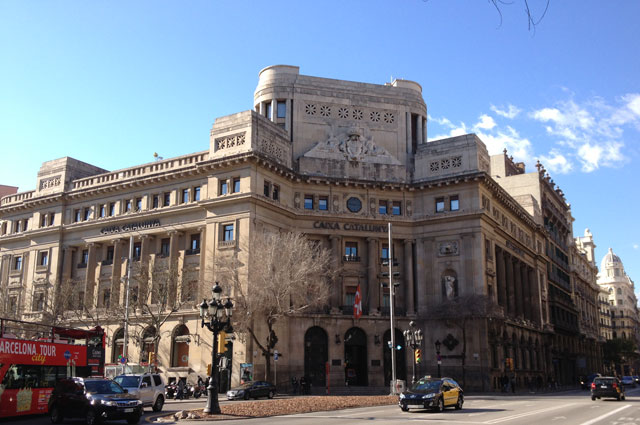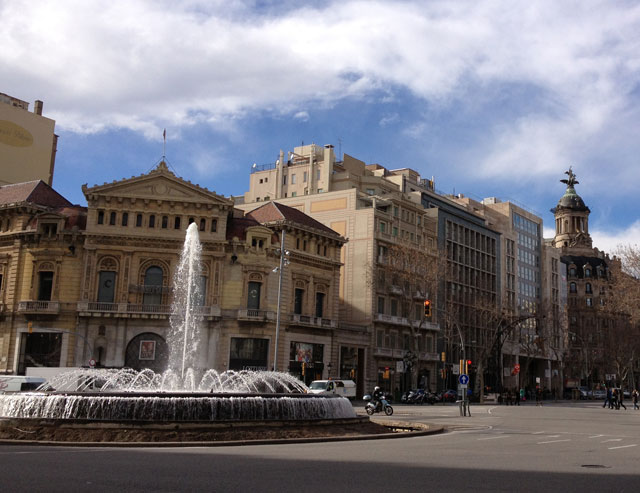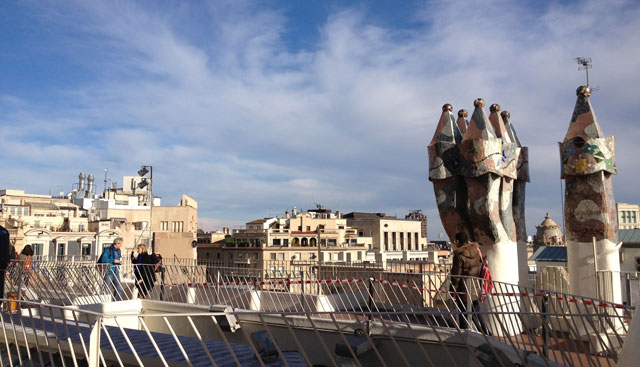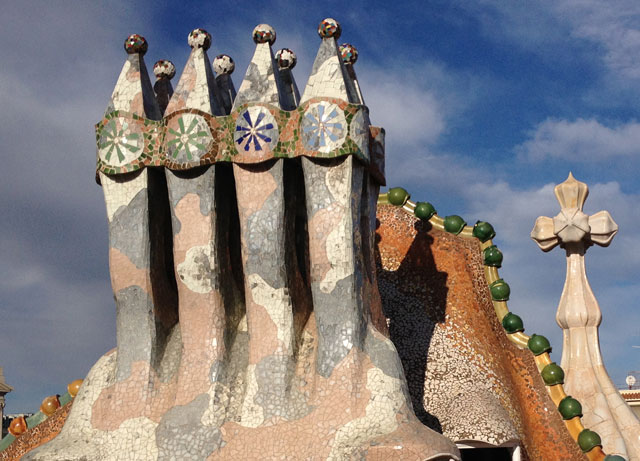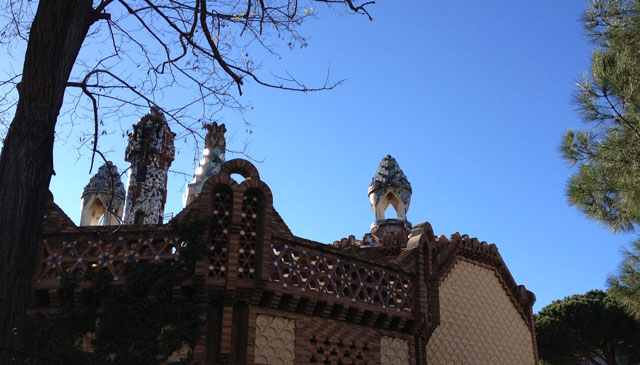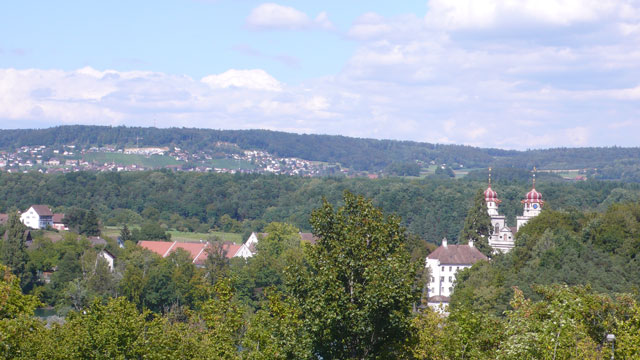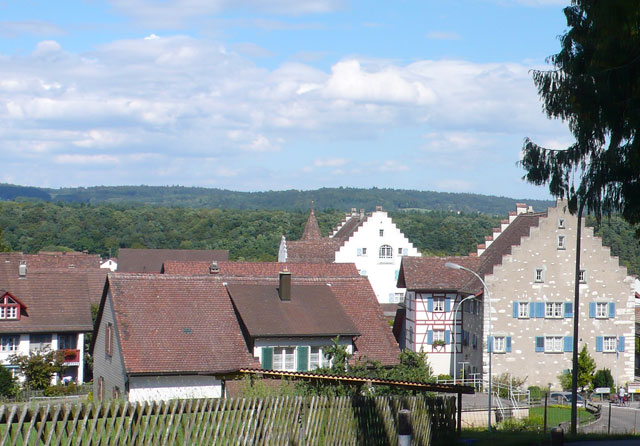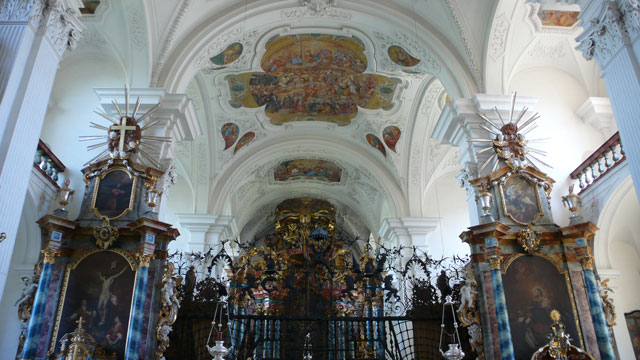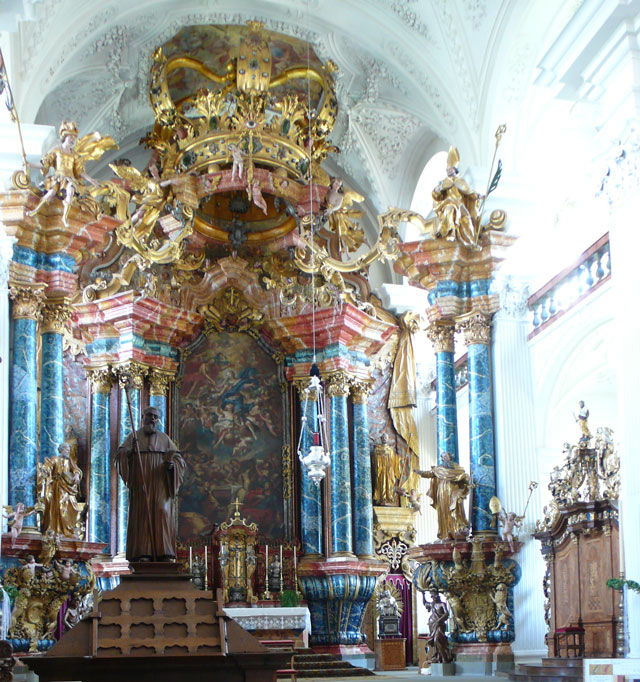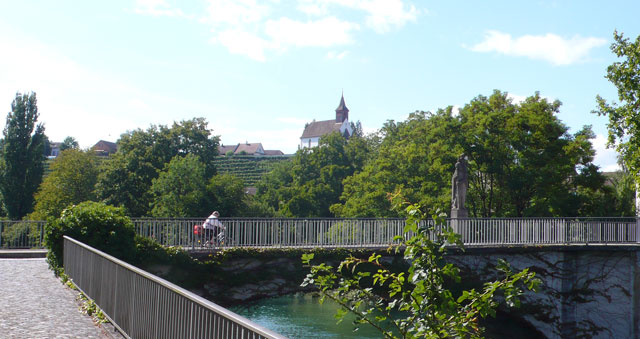One of the things I love about the Mediterranean countries are the shady squares where you can relax and have a coffee or an aperitif. Early February in Barcelona wasn’t quite as warm (or sunny) as we hoped, so we didn’t spend as much time sitting outdoors as we would have liked but we did walk a lot. In Catalan, which is the language spoken by a large majority of the people in Barcelona, the term is plaça which becomes places in the plural.
Category Archives: Architecture
Bussing in Barcelona and a Lost iPhone
After taking the metro once, we decided we’d rather use the bus, particularly since there were no direct metro lines between Sant Pau where we were staying and most of the places we wanted to go. Jean Michel took charge and, after six days, knew his way about better than our home exchange host who has never taken the bus in Barcelona. We took the metro once on the last day and got out at the wrong station.
You can use the 10-ticket metro card on the bus (just under 10 euro) and keep using it for 1 hour 15 minutes, which was handy when had to change bus lines. It was rare not to get a seat and most of the time the bus was half empty, but I guess there are a lot more people in the summer. The big advantage is that you can see where you’re going and it gave me a lot of opportunities to examine the architecture.
The city of Barcelona is laid out on a grid plan, except for the Barri Gotic, the historical quarter, which has lots of little streets arranged more haphazardly. The other streets are very wide and the intersections all form a hexagon. At most bus stops, there are luminous signs indicating when the bus is coming but they are most unreliable. They say “imminent” when the bus has already left and will just from 4 mins to 6 mins and back to 2 mins waiting time for no apparent reason.
One time, the sign said there was a 25 minute wait bus, so we decided to walk down to the next stop that had a better selection of lines. After a couple of minutes, we say the bus go whizzing past. Usually though, the most you have to wait for a bus is about 10 minutes.
Inside the bus, there is a sign indicating the next stop and often a recorded voice to go with it. It took me a while to realise that “Prospera parada” was not actually a stop but means “next stop” in Catalan.
I’m not sure what time the buses start running, but they go until about 10.30 pm. If we went home later than that we would take a taxi, which cost from 8 to 11 euro depending on where we were. There are positively zillions of taxis and you only have to stand on the pavement looking expectantly for one to appear.
When we come out of Cinc Sentitis at midnight on the last evening, a cab immediately pulled up. However, when we reached the flat, I suddenly realised that I no longer had my iphone. I rang the restaurant but they hadn’t found it. Next morning, I rang the central lost & found number for taxis (902101564) and was still hopeful the taxi driver might have found it and handed it in (I’m pretty sure it slipped out of my pants pocket when I sat down – no points for stupidity here).
However, by the time we left Barcelona at 3.30 pm, it still hadn’t turned up. In the meantime, I went to the big Apple store next to Plaça Cataluyna where a very friendly Australian helped me log into my account and declare it as lost. But since International Roaming was switched off (I had been using wifi), there was no way of tracking it. At least none of my photos are lost because I downloaded them all just before we went out for dinner and I synchronised recently.
The Australian sent us to the police station on the Plaça but it would have taken more than an hour to make a declaration and we obviously didn’t want to miss our flight. There were three other lots of tourists declaring missing items, but theirs were all cases of pickpocketing. By the way, all the taxis are identical – black and yellow – regardless of the company. You need to memorise the number each time as you get in or ask for a receipt. Neither of which I did, obviously.
I can see that tomorrow’s going to be a long day organising a replacement with my phone insurance.
Gaudi’s chimneys
Like so many others before us, we’ve become Gaudi fans and fascinated, amongst other things, by his chimneys. All of the houses designed by Gaudi that we visited included the roof with their marvellous chimneys. Gaudi believed that all things useful should also be aesthetically pleasing. Some of the chimneys are used to evacuate smoke while other are for ventilation. They are often highly colourful, and sometimes made with salvaged materials, including broken champagne bottles!
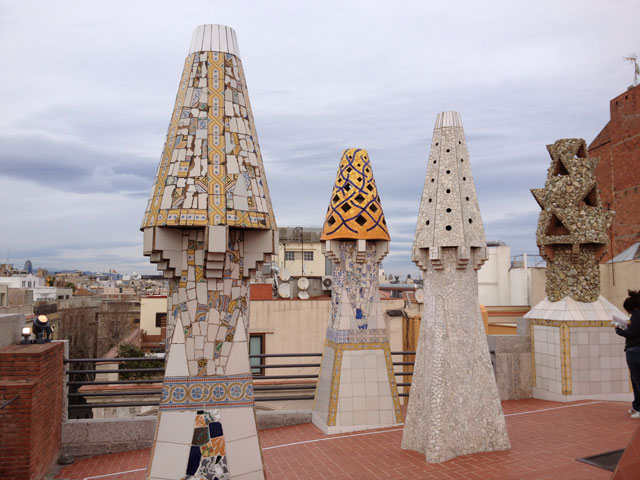
We visited the inside of Guell Palace, Casa Batllo, Casa Mila (also known as La Pedrera) and the Guell Pavilions from the outside only. Our home exchange host, Pep, who’s a musican, tells us that they hold concerts on top of La Pedrera. It must be a truly unique experience.
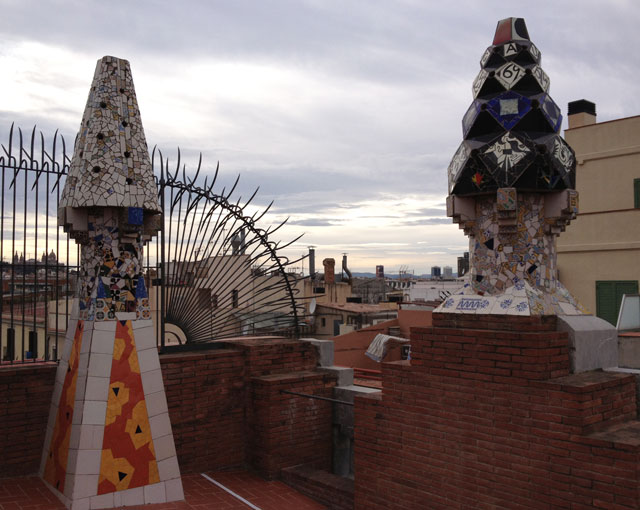
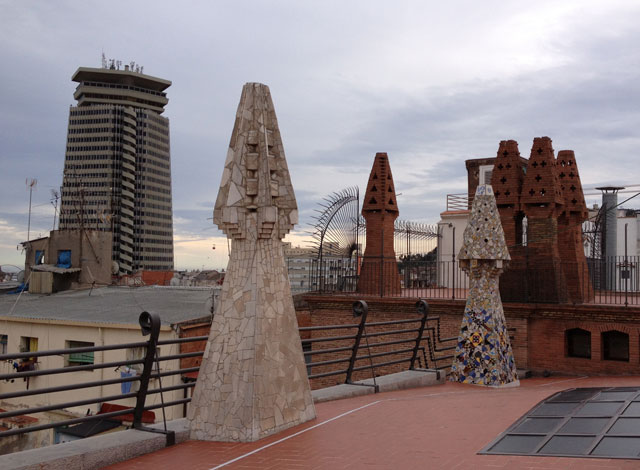
- Chimneys on top of Casa Batllo
- Chimneys on Casa Batllo
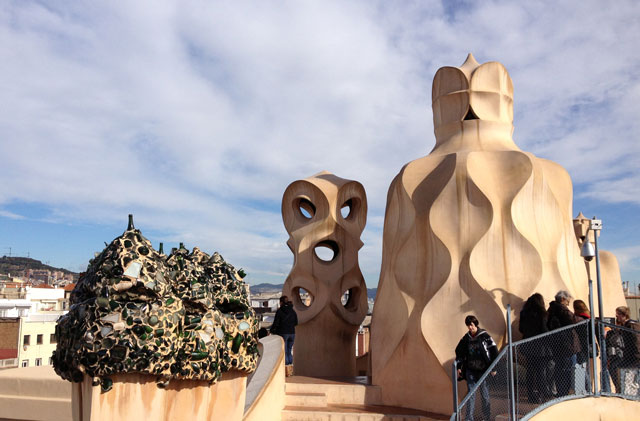
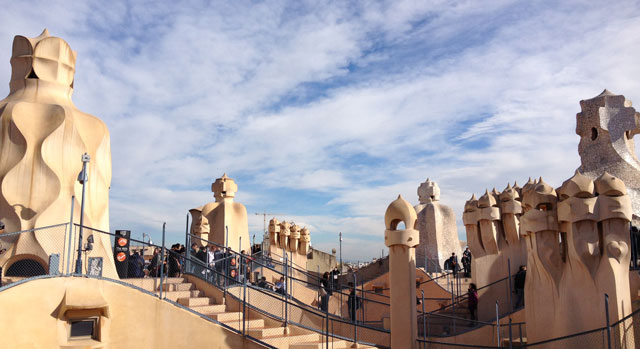
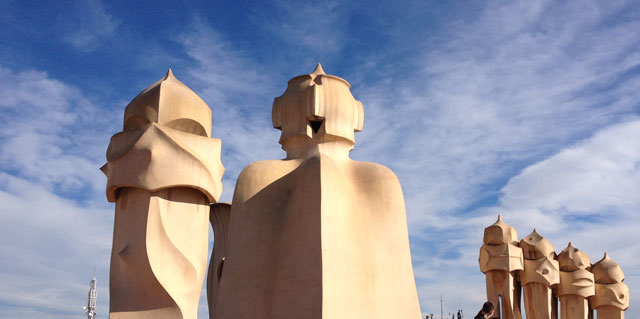
- On top of the Guell Pavilion
Fabulous Gaudi
Ok, just forget what I said yesterday about not being sure what I think about Gaudi’s basilica. It is the most wonderful construction I’ve ever seen. Inside it is absolutely dazzling, breathtaking, overwhelming. There are no words to describe it and no photo to do it justice. It is the most amazing well of light imaginable. The brightly colourful stained glass windows which anywhere else would be gaudy, are quite superb.
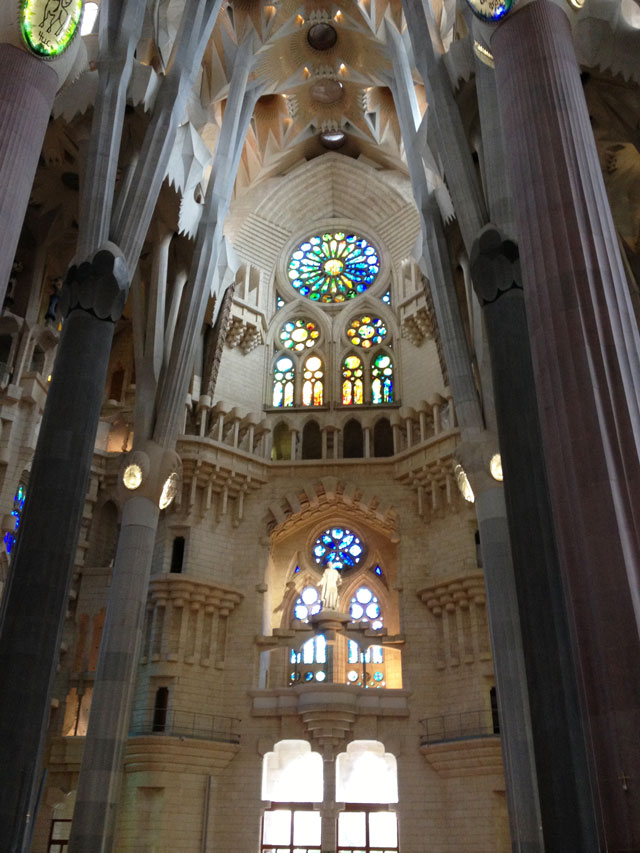
Gaudi was just only 31 when he began working on the cathedral in 1883. It evolved considerably during his lifetime, becoming more and more audacious. Sadly, he was run over by a tram at the age of 73. Some of the mock-ups and nearly all the plans were destroyed by fire during the Civil War in 1936.
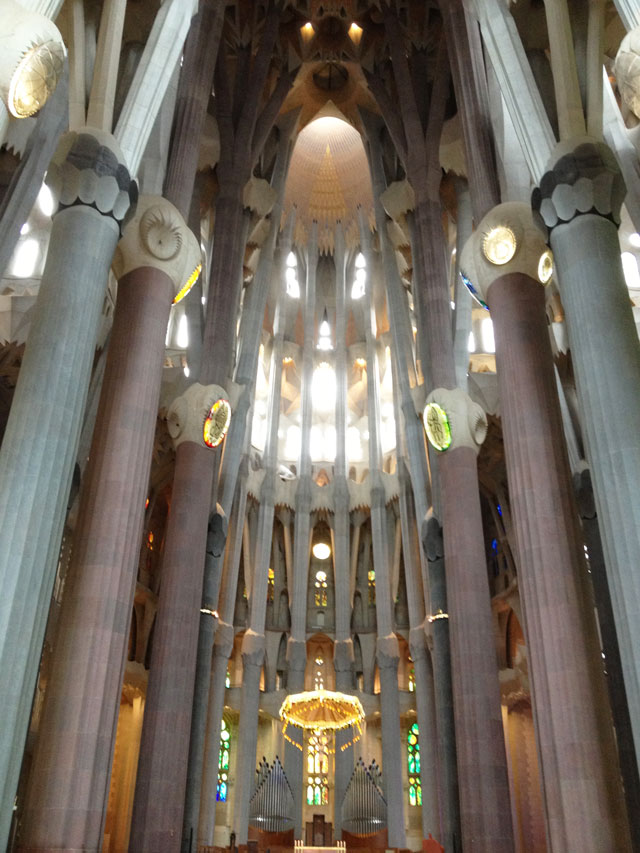
Although it felt like the biggest church I’ve ever been in, it’s amongst the highest but not the longest. The longest of the five naves is 90 metres long and 45 metres wide while the transept is 60 x 30 metres. The highest point is 45 metres from the ground. In comparison, Notre Dame is 127 metres long x 48 m wide, the transept is 48 x 14 metres and the height is 35.5 metres. Beauvais in the north of France holds the world record with 48.5 m.
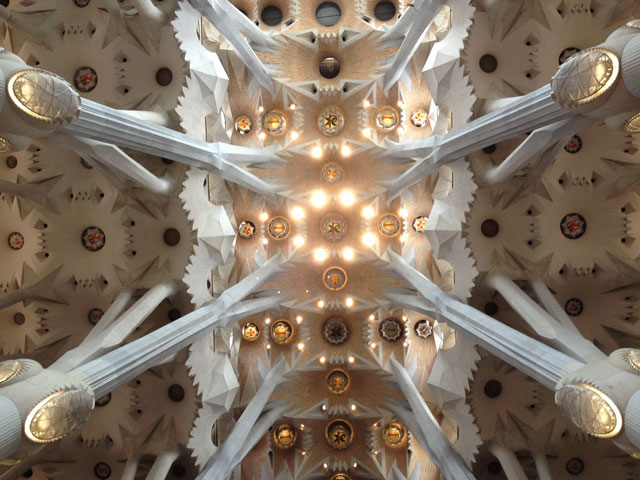
The pillars, which split into two halfway up to remove the need for flying buttresses, represent trees in a forest with leaves at the top but the symbolism isn’t all that obvious. The pillars themselves have a special spiral design with fluting that increases in number as it gets higher.

Although the inside is fairly complete and two of the façades – the Nativity and the Passion – are finished, there is a still a third façade, the Glory, under construction along with the central spire. Up closer, the seemingly naive statues on the Passion façade are true works of art by a controversial Catalan sculptor and painter, Josep Maria Subirachs. Those on the Nativity side are much more conventional and characteristic of Gaudi’s naturalistic style, very ornate and decoratd with scenes and images from nature.
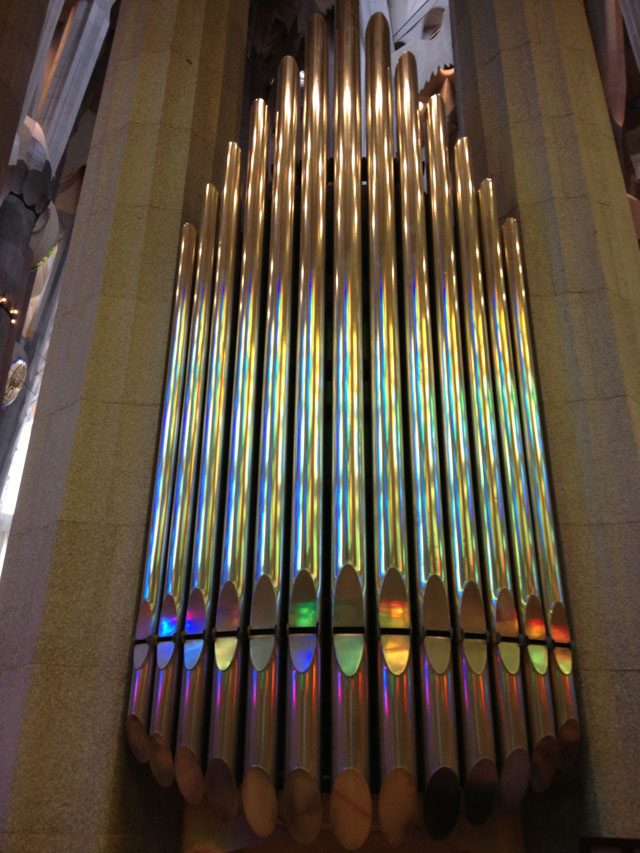
Surprisingly, the crypt, which was built first, by another architect, is very classical. It can be seen through glass walls. We didn’t visit the towers.
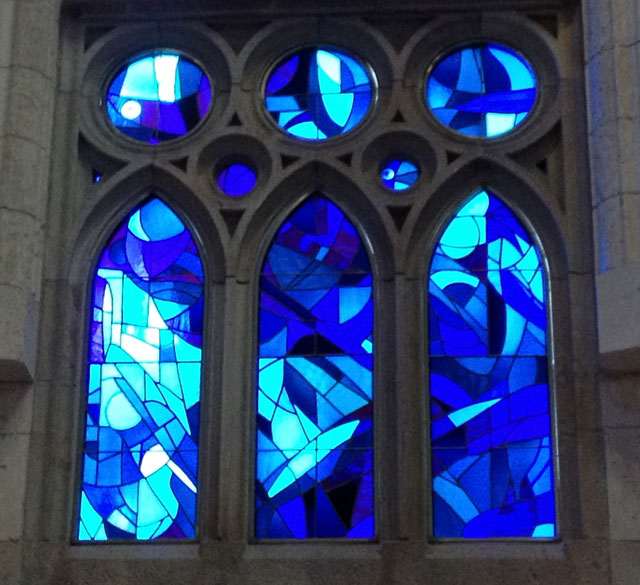
In the photos, I’ve tried to convey the impression of height and light, but it seems impossible. Even when we went back inside after looking at the two façades, we no longer had the same overwhelming impression that we had when we first went in. It’s difficult to take photos of the outside because you can’t stand back far enough. It’s a pity there isn’t an esplanade around it. There are parks across the road, but traffic in-between.
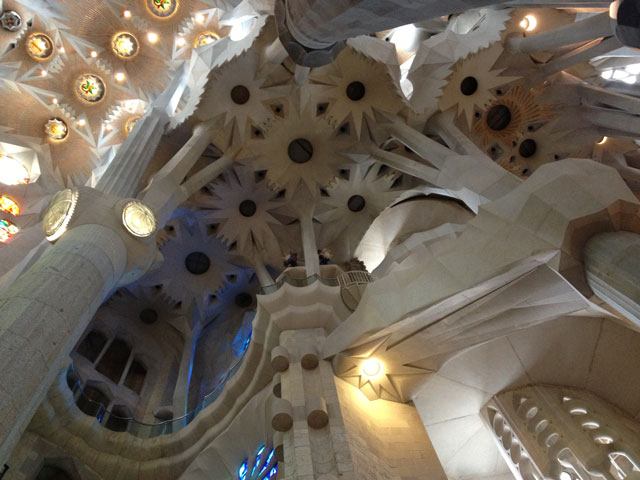
On a purely practical level, given the very long queues, it’s best to buy your ticket on-line. There are lots of different websites, all of which charge a lot extra. You need to go to the official website of the Sagrada Familia which takes you to www.ticketmaster.es. Either you print out your tickets or you go to a Caixa bank with a ServiCaixa machine. You insert the bank card you used to pay on-line, then follow the instructions starting with « Collect tickets ». We went to the bank just opposite the very helpful tourist office next to Plaça Jaume but there are plenty of others.
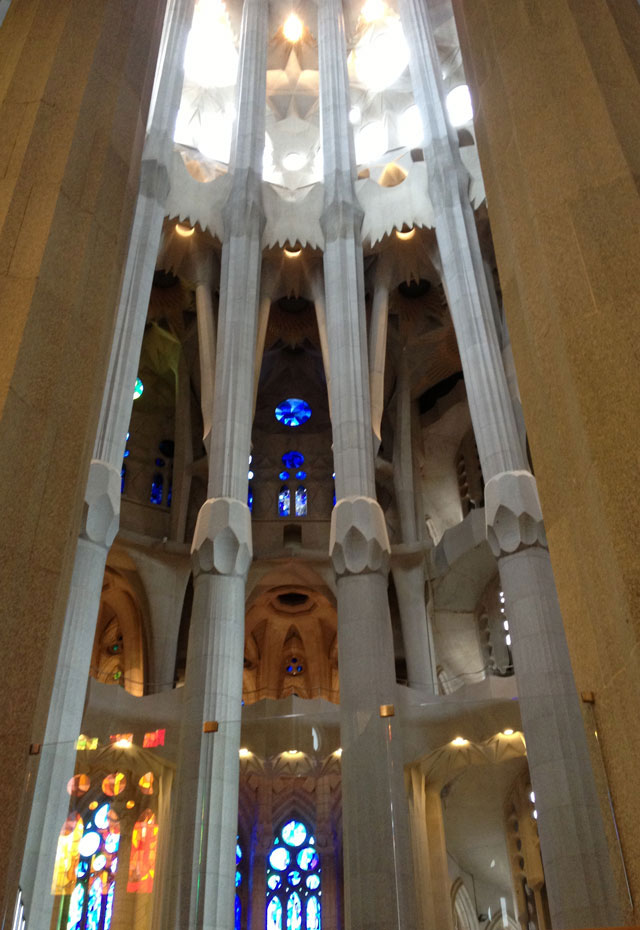
The tickets were 14.80 euro per person without the audio guide, slightly more than you pay if you queue for an hour. In retrospect, I think we should have taken the audio guides because they included the underground exhibition. We decided not to because 1 ¾ hours seemed a long time, but in fact we spent more than 2 hours there altogether. You are given a one-hour slot during which you must enter at a special gate just next to the regular ticket office and there is absolutely no queue.
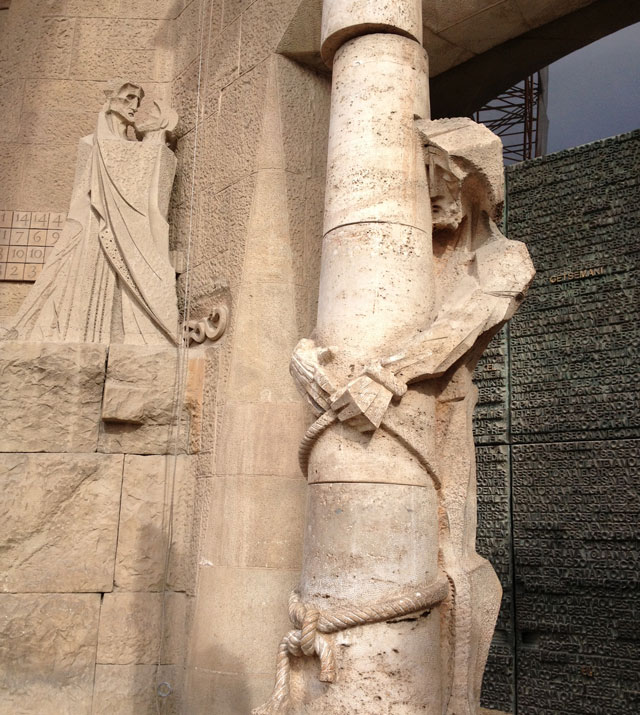
There is a queue for the toilet however but I discovered a second lot right down the far end of the underground exhibition where I could go straight in.
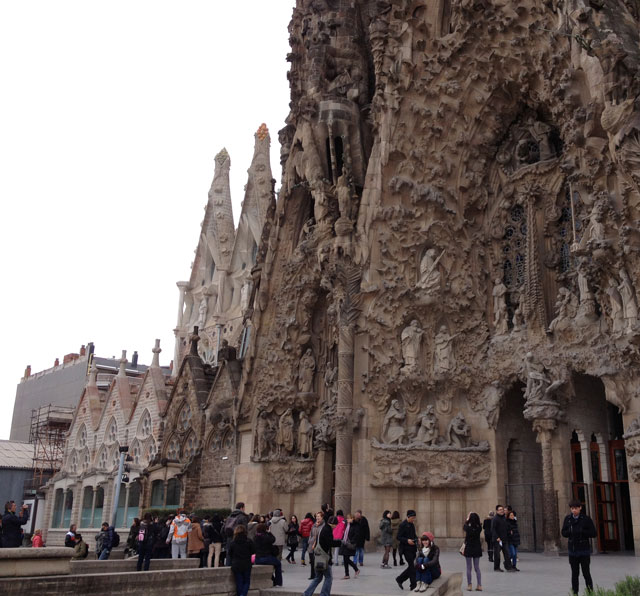
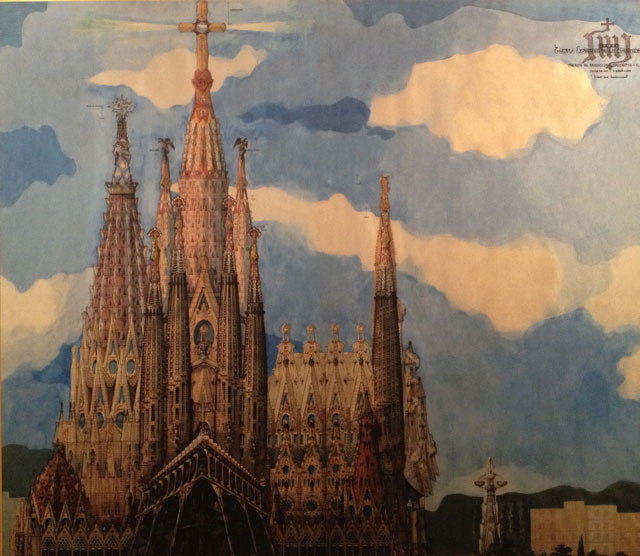
Link to buy on-line tickets
http://www.ticketmaster.es/nav/en/mucho_mas/barcelona/basilica_de_la_sagrada_familia_08su/visita_general/entradas.html
First Impressions of Barcelona – Gaudi and Pintxos
The trip with Easy Jet went perfectly and we even arrived early at our home exchange which gave us time to have a look around us. We’re just across the road from the former Hospital de la Santa Creu i Sant Pau in the El Guinardo neighbourhood, built between 1901 and 1930 and now a UNESCO World Heritage site. It ceased to be a hospital in 2009 and is undergoing restoration for use as a museum and cultural centre.
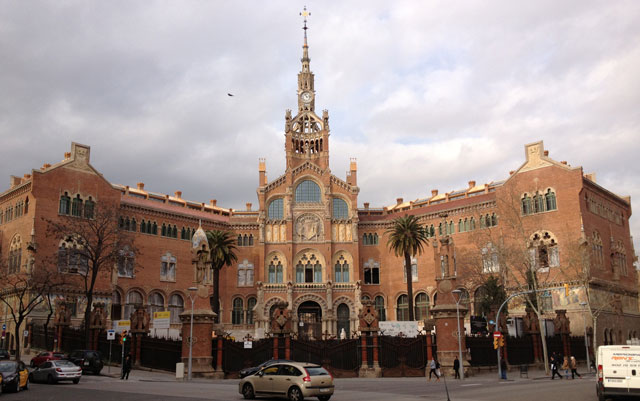
When you turn your back to Sant Pau you are looking straight at Gaudi’s famous Sagrada Familia cathedral. Our flat is on the 5th and last floor and a small flight of stairs leads onto a terrace where we have a spectacular view of the hospital. Unfortunately it’s a little cold to take our deck chairs up or we could have breakfast there!
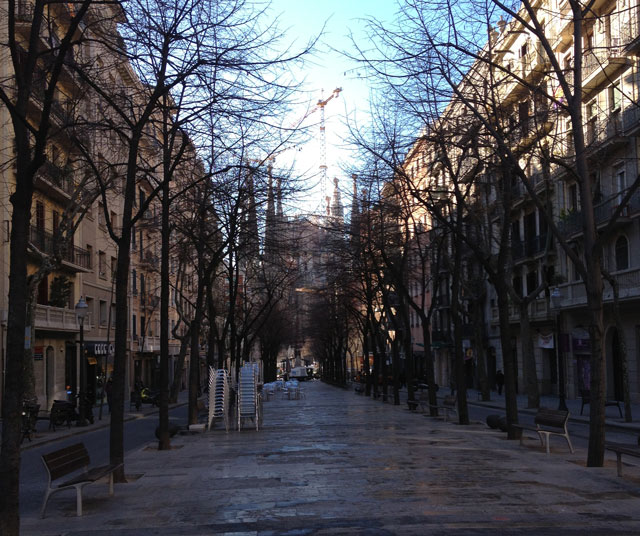
In the evening, at Pep’s suggestion, we went into the Barri Gotic which is the historical quarter of Barcelona. We decided we’d walk and it took an hour and a half! We were justly rewarded though. Pep had recommended a tapas restaurant called Bilbao Berria on the corner of Plaça Nova with its beautiful Gothic cathedral. We weren’t able to visit the inside because it was just closing.
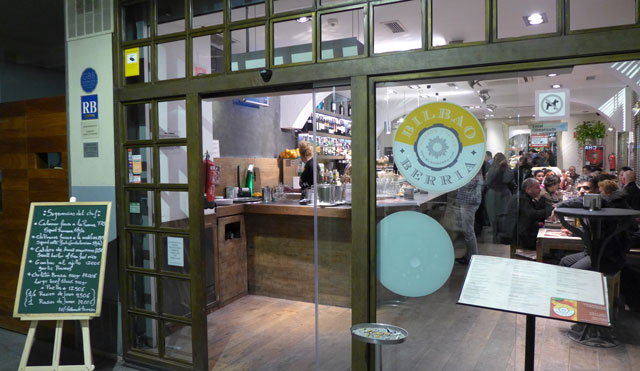
We found the restaurant and it was so good that I have a sneaky suspicion that we are going to be disappointed wherever else we go. Theoretically, they weren’t tapas, but « pintxos », which are hot or cold finger foods with a skewer through them which you choose yourself from the bar. They all cost 1.65 euros a piece and from time to time, the waiter comes around and puts the skewers in a glass. At the end, he counts them all up. So much easier than looking at a menu!
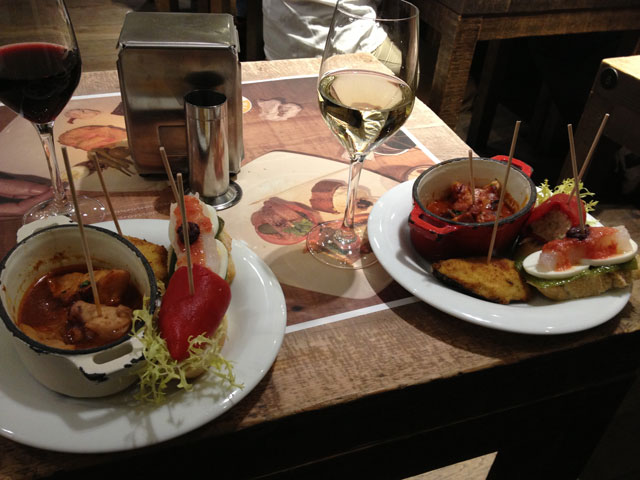
After all that walking, I stayed put and let Jean Michel choose the tapas. The variety was amazing. There were even mini hot dishes, one octopus and the other veal. My favourite had two sea scallops and 3 prawns! I have to confess we had second helpings, then I went and chose a couple of desserts! We decided to take a taxi home. They’re very reasonably priced here.
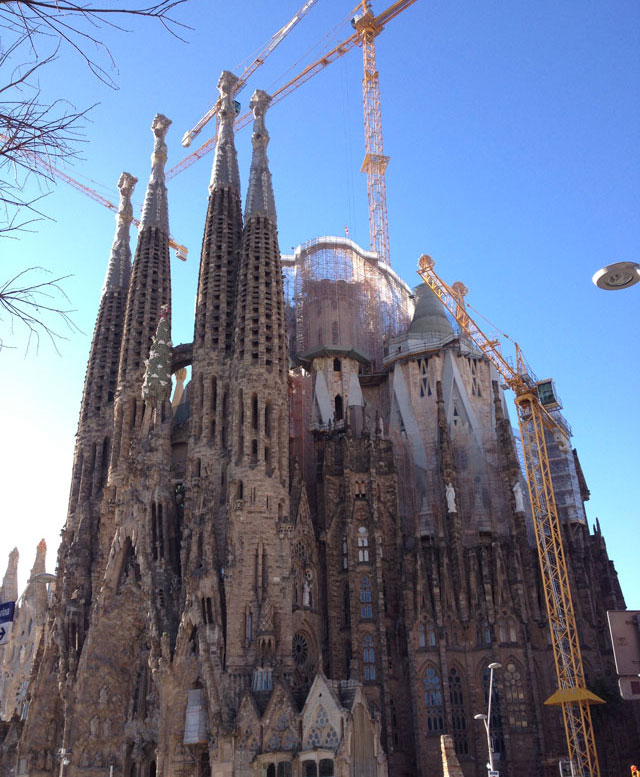
Next morning we went and had a closer look at Gaudi’s unfinished cathedral but when we saw the queues of people waiting to get in, we decided to get tickets on line and come back another day. I’m not sure yet what I think of the cathedral. It’s very impressive, like a series of enormous stelactites but I’m not sure I like the naive sculptures and gaudy colours. I did wonder whether the word comes from the artist, but apparently it doesn’t.
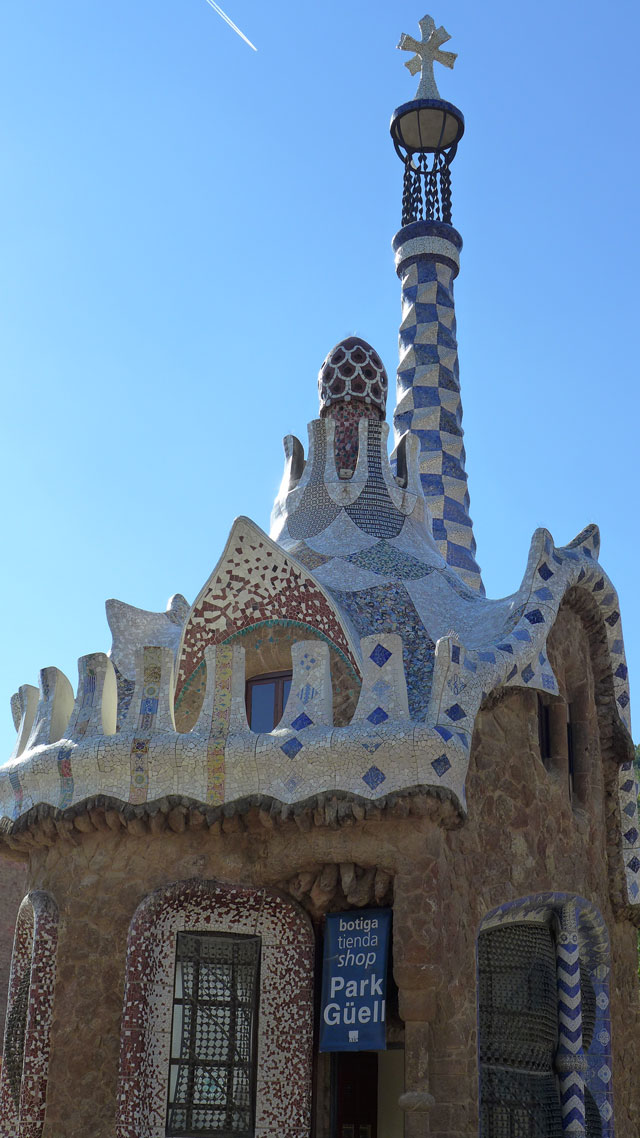
We then took the very modern metro to Guell Park, also decorated by Gaudi. A 10-ticket card that can also be used for the bus costs just under 10 euros, which is much cheaper than Paris. It took about 20 minutes to walk up the hill to the park from the metro station but despite the cold, the sun was out.
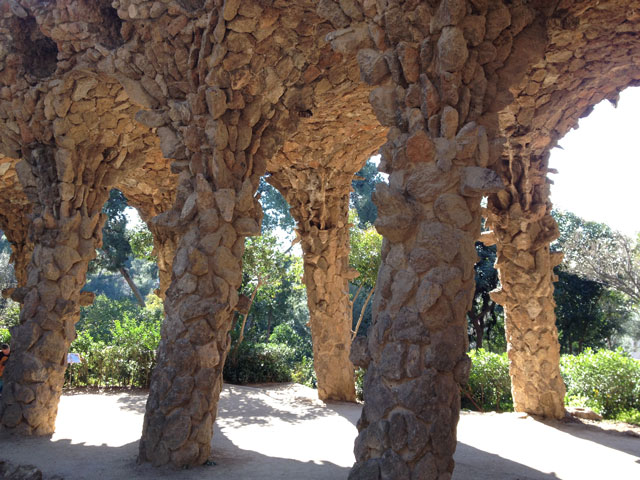
I really liked the park, which was never finished, like a lot of Gaudi’s work, because Count Guell eventually ran out money. When we got there, there weren’t many people but by the time we left, it was crowded. Initially though it was very still and peaceful, with musicians scattered about playing classical music and Spanish guitar. From the top there are sweeping, though a little hazy views of the city of Barcelona and the sea. So when we left the park, that is where we headed.
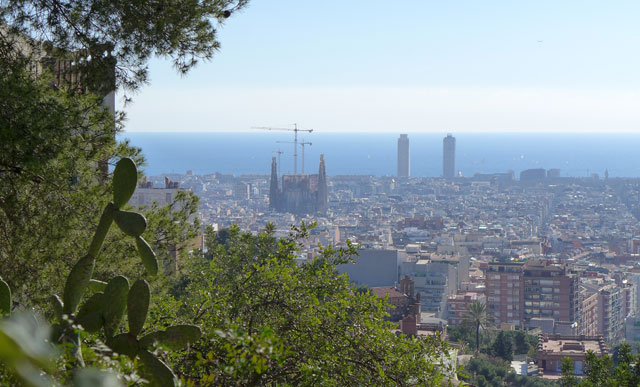
Premises of Spring in Biting Cold Paris to Greet the New Bells at Notre Dame
On the way to the Sainte Eustache market on Sunday, delighted to have sun at last, we walked past a garden bed of primroses. I couldn’t believe it! The vendors at the market were bright and cheery this week as well. It’s amazing what a little sun can do to the morale of the population in the throes of winter.
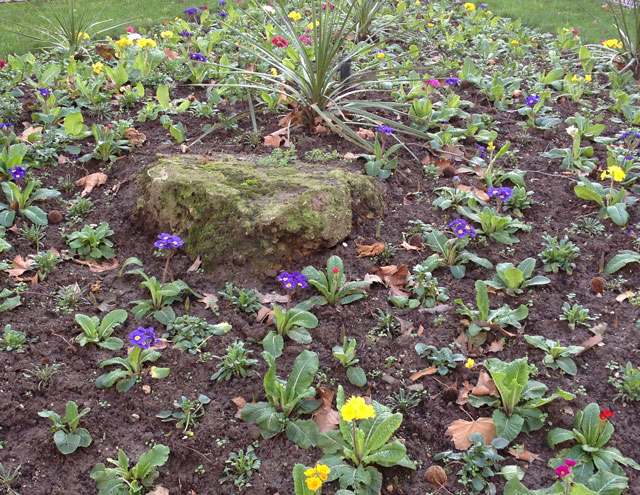
However, by 3 pm, when I joined my Australian cousins from Armidale who are visiting Paris at the moment, the sun had disappeared and it was biting cold. We met up in a café just near Paris’ beautiful Gothic town hall and I suggested that even if they were stilling feeling a bit cold, it would be better to remove their anoraks inside so that when they went outside again, they wouldn’t feel the cold as much.
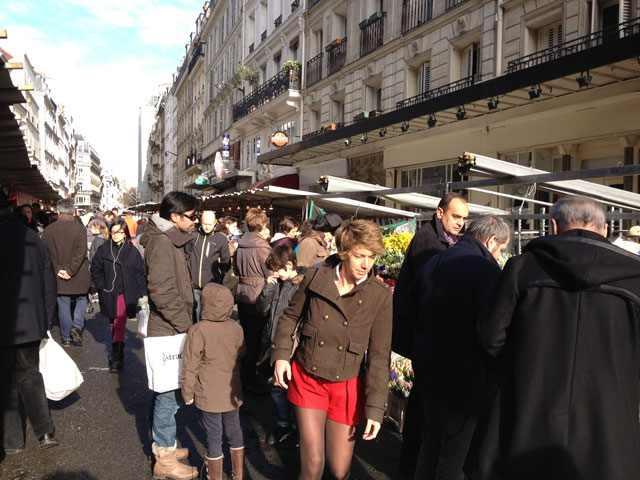
When we came out, we could see the newly renovated golden spire of the Conciergerie in the background. We crossed the bridge towards Notre Dame where I was surprised to see a grandstand, then I remembered the bells. Notre Dame is celebrating its 850th anniversary this year and one of the major events is a new set of bells.
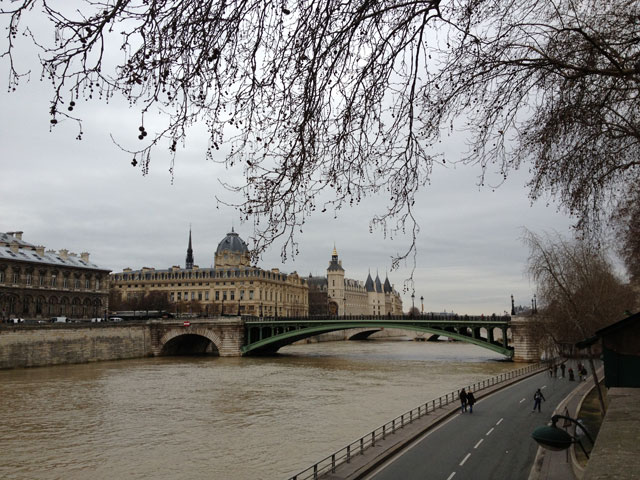
Marie, Gabriel, Anne-Geneviève, Denis, Marcel, Etienne, Benoît-Joseph, Maurice and Jean-Marie arrived in Paris last Thursday on two 43 tonne trailers from Villedieu-les-Poëles in Normady with a motor cycle escort. They’ll be on exhibit in the nave of Notre Dame until 25th February, which probably explains and longer than usual queue ! Their first peal is scheduled for 23rd March.
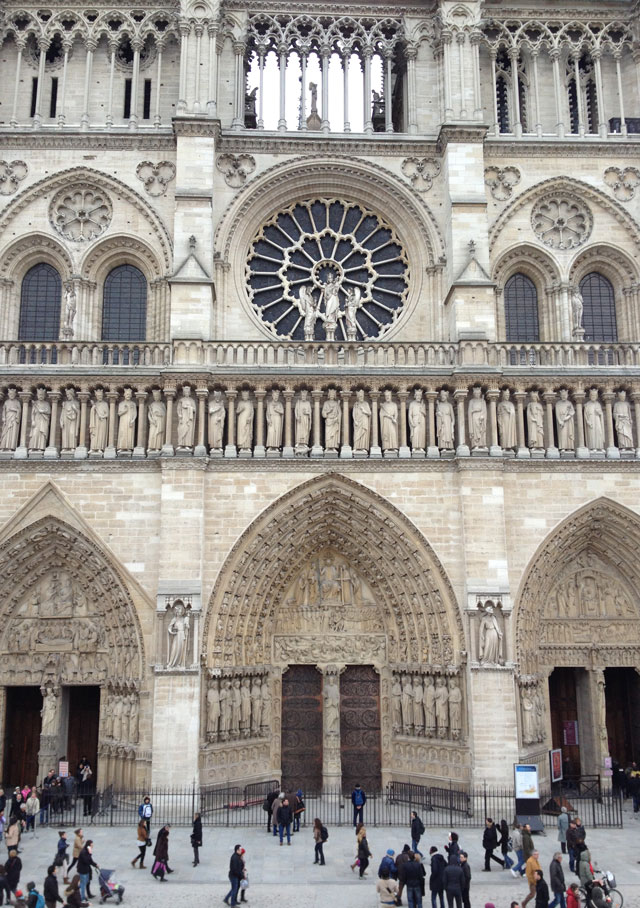
The grandstand, which can seat 800 people, is designed to offer visitors a unique view of the cathedral’s three porches and rose window, whose details are difficult to see from the ground. It certainly is spectacular although you can no longer stand back and fully appreciate its majesty. It seems that all sorts of sound and light shows are scheduled up until 24th November. I shall wait until it’s a little warmer and go and have a look.
A bittersweet treat: La Chapelle de tous les Saints – Speak like a local: quand the French use quand même – Of Hospitals and Cheese Courses
Last week’s bloggers’ round-up had a single theme – Barcelona – but this week, the subjects are completely different. Chez Charnizay from the Loire Valley offers us a very complete description of the danse macabre, a mediaeval allergory for death, depicted in a local chapel in Touraine. Katerina Forrester, posting on My French Life, examines all the different things that “quand même” can mean, while Bread is Pain comments on French hospital food, very far from the pizza and jello she remembers having in the US as a child. Enjoy!
A bittersweet treat: La Chapelle de tous les Saintes
by Niaill, a Scotsman, and Antoinette, a Dutch American, from Chez Charnizay, who live in the village of the same name in southern Touraine and blog about their adventures in the Loire Valley.
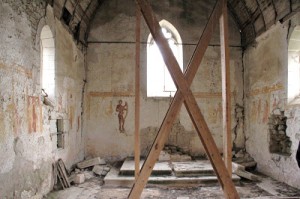 A little while back, friends Susan and Simon who write the blog Days on the Claise ran into Marc Dimanche, an acquitance of theirs. A devoted member of the Preuilly archaeological society, he offered them the opportunity to visit the Chapelle de tous les Saintes [All Saints’ Chapel] which is located on the left as one drives into Preuilly-sur-Claise from the direction of Le Grand Pressigny. They had written a post about the chapel before here, but had never had the opportunity to see inside. Read more
A little while back, friends Susan and Simon who write the blog Days on the Claise ran into Marc Dimanche, an acquitance of theirs. A devoted member of the Preuilly archaeological society, he offered them the opportunity to visit the Chapelle de tous les Saintes [All Saints’ Chapel] which is located on the left as one drives into Preuilly-sur-Claise from the direction of Le Grand Pressigny. They had written a post about the chapel before here, but had never had the opportunity to see inside. Read more
Speak like a local: quand the French use quand même
By Katerina Forrester, Australian born but always longing to be French, posting on My French Life, the global community of French and francophiles connecting like-minded people in English & French.
 It’s a phrase that stops a nation, or more so, a young girl at the ripe age of 16 on her first trip to France. This common French expression would continue to stump me for years to come, and I’m ashamed to add that the first time I heard this phrase, I transcribed it as ‘comme même’.
It’s a phrase that stops a nation, or more so, a young girl at the ripe age of 16 on her first trip to France. This common French expression would continue to stump me for years to come, and I’m ashamed to add that the first time I heard this phrase, I transcribed it as ‘comme même’.
However, I shouldn’t be disheartened by my cultural linguistic naivety. This typical French expression, quand même, may be easily translated into English, but the translation changes drastically depending upon the context!
So let’s identify and explore quand même on the dissecting table…through hypothetical situations. Read more
Of Hospitals and Cheese Courses
by Bread is Pain, a 30-something American living in the Rhone-Alps, and slowly eating and drinking herself through the country
Now granted, I haven’t been in the hospital in the U.S. since the 80′s so my information isn’t at all up to date but what I remember of the food was pizza and jello (I was also 8 years old which might account for what stands out in my mind). At the hospital here in Grenoble, however, MB’s meals are somewhat more sophisticated. There is a potato soup, there is a tuna pasta, a freshly baked roll, fromage blanc. These may show up all at the same time but this is basically a 3 course meal…in the hospital. Yesterday he had saucisson…how is that a healthy choice? Read more
Monday’s Travel Photos – Klosterkirche Rheinau in Switzerland
We were staying near Stein am Rhein in Switzerland and on our way back from visiting Schaffhausen and its Rheinfall, the spectacular waterfall on the Rhine, I suddenly spotted the most amazing church in the distance. It turned out to be the Klosterkirche Rheinau monastery church, one of Switzerland’s most significant religious buildings. The original 12th century basilica, built on an island on a strategic bend in the Rhine River was rebuilt in the Baroque style in the first part of the 18th century and turned into a monastery church. The inside is quite stunning.
French Renovations in the Loire Valley
I thought I would use my guest post on My French Life this month to do a recapitulation of the renovation of our Renaissance fireplace in Closerie Falaiseau, our 400-year old house in Blois. I know that some of you waited with bated breath as we converted it from a “bandy-legged monster” as Barb Hall so aptly called it in a comment, to a straight and dignified fireplace ready to use.
The hearth looks a bit stark at the moment but once the fireback is in and the logs are in place and there’s a roaring fire going, it should look a bit more attractive!
French Renovations in the Loire Valley
posted on My French Life, the global community of French and francophiles connecting like-minded people in English & French
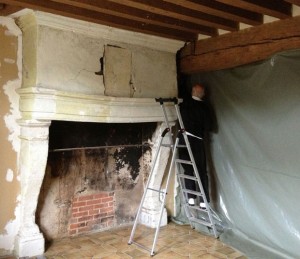 The first time we visited Closerie Falaiseau, a beautifully restored Renaissance home built in 1584 near Blois in the Loire Valley, we didn’t see the upstairs fireplace. It was almost completely covered up with a large wardrobe.
The first time we visited Closerie Falaiseau, a beautifully restored Renaissance home built in 1584 near Blois in the Loire Valley, we didn’t see the upstairs fireplace. It was almost completely covered up with a large wardrobe.
So on the second visit, we asked if the cupboard could be moved. But it was very heavy and we only had a partial view. It was not until we signed the final deed of sale and saw the house empty that we had any real idea of the state of the fireplace and even then, it turned out that a large rattan fan was hiding a gaping hole filled with cement. Read more
Barcelona: Gastronomic Dining – Things to do in Barcelona – Gaudi’s Barcelona
The posts on my Wednesday Bloggers’ Round-Up today are all by Australians (or people with Australian connections) and all on the subject of Barcelona. Kathy Stanford from Femmes Francophiles has suggestions for both fine dining and casual dining in Barcelona, Craig Makepeace from Y Travel Blog offers lots of insider tips on things to do while Laurence from Finding the Universe offers us spectacular photos of Gaudi’s monuments that I can’t wait to visit! So let’s go to Barcelona!
Barcelona: Gastronomic Dining
by Kathy Stanford from Femmes Francophiles, an Australian who an ongoing passion for France and the French language just back in Australia after a holiday in Europe
 I visited Spain for the first time in 2001 as part of a whirlwind tour around Europe. I couldn’t understand people who raved about Spanish food. The food served to tourists on bus trips is generally lacking flavour and unexciting. All this changed last year when I stayed with Isa and Julio in Andalusia. What a revelation.
I visited Spain for the first time in 2001 as part of a whirlwind tour around Europe. I couldn’t understand people who raved about Spanish food. The food served to tourists on bus trips is generally lacking flavour and unexciting. All this changed last year when I stayed with Isa and Julio in Andalusia. What a revelation.
In January this year, in addition to tapas, I was fortunate to dine in the Michelin starred Cinc Sentits restaurant in Barcelona. Read more
Things to do in Barcelona
By Australian blogger Craig Makepeace from Y Travel Blog, who, with Caz, believes that life is about creating great memories and making it a story to tell, and they do that through travel.
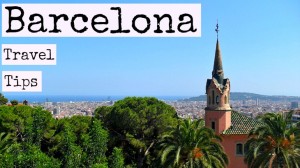 Looking for tips on things to do in Barcelona? As part of our city guides series, we interviewed Mariana Calleja from Travel Thirst who has been in Barcelona since January 2010, fell in love with the place, and decided to stay longer. Mariana shares with us her insider tips on the best things to do inBarcelona plus where to eat, sleep, drink, shop and explore. Why Visit Barcelona? Barcelona is a very rich city in many aspects. The easiest way… Read more
Looking for tips on things to do in Barcelona? As part of our city guides series, we interviewed Mariana Calleja from Travel Thirst who has been in Barcelona since January 2010, fell in love with the place, and decided to stay longer. Mariana shares with us her insider tips on the best things to do inBarcelona plus where to eat, sleep, drink, shop and explore. Why Visit Barcelona? Barcelona is a very rich city in many aspects. The easiest way… Read more
Gaudi’s Barcelona
by Laurence from Finding the Universe, of British origin who, with German-born Vera, are both travellers, into writing and photography, slowly exploring the world.
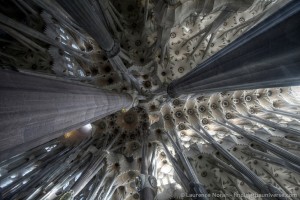 Gaudí. It’s kind of hard to visit Barcelona without spending your time gaping in awe at the architectural and artistic genius that he left behind all over the city.
Gaudí. It’s kind of hard to visit Barcelona without spending your time gaping in awe at the architectural and artistic genius that he left behind all over the city.
A great deal of my week in Barcelona was therefore spent, gaping in awe, at his many truly incredible constructions. As well as gaping, I was also taking the odd photograph, which I’m sharing with you today. I wasn’t able to visit every bit of work he did, but I’d like to think that I took in the serious highlights.
In a future post I’ll be going more into the details of what to see and do in Barcelona. For now though, less detail: more eye candy.
Lets start with… Read more




